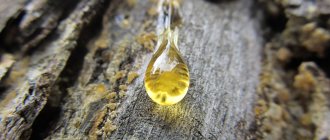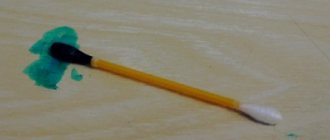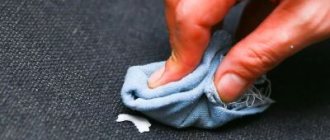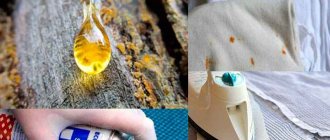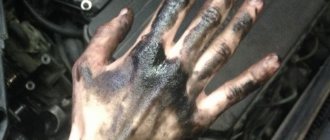You can often see resin on the trunks of coniferous trees, which can easily get dirty while walking.
Sticky and viscous, it can seriously stain clothes. Resin is a complex contaminant that cannot be dealt with quickly. It will be even more difficult to remove dried stains.
How and with what to remove pine resin from clothes at home, how to remove stains? You will find answers to questions in the article.
Features of spots
Wood resin is a product of organic origin. The sap secreted by trees has a thick consistency and complex composition .
Wood tar is viscous and oily, and has a brown color. Resin is formed during the hardening process of pine sap.
Fresh and hardened resin from coniferous trees actively reacts to heating and freezing. This circumstance can be taken advantage of, especially in cases where it was not possible to remove the resinous drop before it set.
Freezing makes the resin brittle . In this state, it crumbles easily and can be removed from the material quite easily.
Removal methods using heating are more complex in technology and are not suitable for processing synthetic fabrics and other materials that do not tolerate heat.
The item needs to be prepared for heat treatment:
- If the stained clothing has a lining, it is paired so that the fabric with the stain is in one layer.
- Before you handle the iron, you need to apply napkins with good absorbency on both sides of the stained area.
- As the resin warms up and is absorbed, they will need to be replaced with new ones.
In addition to pine, other trees also release resin - larch, spruce, thuja, etc.
Preparing for cleaning
Having discovered a dark tar stain on the leg or sleeve of a blouse, the first thing you need to do is remember how it could have appeared. If trouble occurs after a walk in a park planted with coniferous trees, or while picking mushrooms in a pine forest, then we are talking about tree resin. It’s another matter if the stain appeared during repairs or after going to a construction site. In this case, we can assume that the resin is epoxy.
Resin type – wood (natural) or epoxy
There are two types of resins: natural, or wood, and synthetic. But they are all characterized by incredible stickiness, the ability to quickly penetrate the fabric fibers and glue them together.
Before cleaning begins, it is necessary to correctly determine the type of resin.
- Tree resin (tar) is a viscous, oily liquid of a dark brown color. It is formed as a result of the hardening of the sap of some trees. Resin is produced by pine trees, spruce trees, larches, poplar buds, thuja and other plants.
- Epoxy resin is a representative of synthetic substances, as it is produced chemically. Such resins are widely used in households, construction, and manufacturing. Epoxy exhibits its binding properties only when combined with a hardener and is resistant to acids and alkalis.
Vegetable stains are much easier to remove than stains caused by epoxy resin.
Fabric material
To select a cleaning product, it is important to know what fabric the stained jacket or blouse is made of. Otherwise, a hole may form in place of the stain, the paint may peel off, or some other problem may occur.
The composition of the material and methods of caring for the product are indicated on the label. If the information is erased or the label is cut off immediately after purchase, you should follow these rules:
- Wool and natural silk do not tolerate exposure to strong alkaline solutions. To clean the surface of these materials from resin, ammonia or a mixture of starch (1 tsp) and turpentine (5-6 drops) is used.
- Turpentine or acetone will help remove the viscous substance from cotton fabric. When the resin has dissolved, wipe the contaminated area with alcohol and rinse with water.
- Acetate silk and bologna fabric are treated with purified gasoline. Acetic acid and acetone should not be used to process these materials.
- Nylon and nylon do not tolerate treatment with gasoline, benzene and alkaline solutions. Resin stains from these materials must be removed with warm water and laundry soap.
- Leather items cannot withstand exposure to solvents. For them, the best cleaning agent is vegetable oil.
- Jeans stained with wood resin can be easily cleaned with turpentine and ammonia, using them in equal quantities. Potato starch is added to the solution to obtain a thick paste, and the area of contamination is coated. After drying, the remaining paste is brushed off and the pants are washed.
- A jacket made of membrane fabric can be scrubbed using turpentine and laundry soap. Turpentine is diluted with water in a ratio of 1:2, grated soap is added to the mixture and the soiled part of the clothing is washed.
Fresh or old stain?
A fresh stain that has just appeared is always easier to remove than an old one. Therefore, as soon as a resin blot is discovered, you must immediately begin cleaning:
- Use a paper napkin or handkerchief to blot the resin, trying to collect a thick mass from the surface of the material.
- Do not wash, much less soak, the product. This will not help the matter; the stain will spread even more.
- If you don't have a stain remover on hand, you can try to get rid of the stain using vegetable oil. In case of failure, you will have to start processing with other substances suitable for the composition of the fabric.
Fresh stains usually have a blurred outline and are darker in color than the fabric. Old stains have a clear outline, they are lighter than the fabric, and appear both from the face and from the inside.
How to prepare things for stain removal?
Before applying the cleaning agent, the affected product must be prepared as follows:
- Shake out the dust and clean the surface of the clothing with a brush.
- Test the durability of the fabric in an inconspicuous area, such as a pocket or side inseam.
- Place the product on a table or floor and place a board wrapped in cotton material under the stain.
- If the product has a lining, it is peeled off in advance so that it is possible to place a board between the top and the lining fabric.
- The fabric around the stain is moistened with water. This will prevent the formation of divorces.
The product is ready for cleaning. Now all you have to do is choose the right tool - and you can get to work.
How to clean fresh?
Most of the resin that gets on clothes has a viscous, thick consistency. In this form, you can try to remove it with a napkin. After removing the top layer, a mark will remain on the fabric, which will have to be removed separately.
When working with liquid resin, it is necessary to ensure that it does not spread over an even larger area of the material. To do this, you can moisten the cloth around the stain with plain water.
remove the resinous composition that hardens in a voluminous drop and dries out mechanically using a knife , spoon or other object. Such actions must be carried out very carefully to avoid tissue damage.
To remove and dissolve the remnants of such a substance, you will need to use drugs that are active against organic resins. They are even easier to remove than synthetic compounds, such as epoxy.
Preparing the spot cleansing area
Before you get rid of any remaining stains, you will need to do some prep work. Clean the product from dust and dirt with a regular clothes brush. The fact is that if, in addition to resin, there are other contaminants on the clothes, mud streaks may form when treated with chemicals.
After this, place the clothes on a flat board, which you have previously wrapped in white cotton cloth, folded in several layers. If the product has a lining, prop it up and insert a board between it and the facing fabric.
Moisten the material around the resin blot with water and sprinkle starch on top (talc can be used). This will create a barrier that will prevent the resin from spreading throughout the fabric after chemical treatment.
How to withdraw using improvised means?
Traditional recipes are proven methods for removing traces of tree resin, which make it possible to deal with stains at home, without purchasing special products.
Alcohol
Rubbing alcohol purchased from a pharmacy can be used to remove pine tar from clothing items.
This method is suitable for clothes made of dense materials - linen, cotton, denim.
The stained area is treated with a sponge soaked in alcohol. Rub the area of contamination and leave the sponge on top for a quarter of an hour. The remaining pine resin is wiped off with a napkin, and the clothes are washed.
Kerosene, gasoline
Kerosene, like gasoline, can be used to remove pine sap stains. The stain must first be treated with kerosene, then with ammonia.
It is necessary to scrub until a good effect is achieved. If you leave a stain on the fabric, after a while it will be very difficult to remove the residue.
Only purified gasoline is used as a stain remover, which can be purchased in the hardware department of the supermarket.
Turpentine, ammonia and starch
An effective product for removing pine resin from clothes is prepared based on three components:
- 5 drops of turpentine;
- 5 drops of ammonia;
- 1 tsp starch.
All ingredients are mixed in a separate container and generously applied to the resin stain. The composition is left, allowing it to dry. After this, treatment is carried out with a brush. This allows you to remove the starch composition along with the contamination.
White Spirit
In order to scrub jackets and tracksuits made of synthetic fabric, you can use undiluted white spirit.
To do this, a swab or sponge is generously moistened in a solvent and applied, rubbing, to the area with the stain . In this form, it is better to leave the product on the product for half an hour, preventing the tampon from drying out.
After 30 minutes, rub off the stain. The item is washed in the usual way.
How to remove with vegetable oil?
Vegetable oil is an option that can be used to remove tar from a leather surface without any problems. In other cases, the effect of using oil leads to the fact that instead of a resin stain, you have to deal with a grease stain.
In this case, you can complete the cleaning using dishwashing detergent or stain remover .
But for a leather jacket this solution is simple and convenient. The sponge is soaked in oil and the area is treated with rubbing movements. This method allows you to deal with a fresh stain in a matter of minutes, but with old stains it will take time.
You can soak a sponge or napkin with vegetable oil and press it onto the stained area. In this state, you need to leave the jacket for an hour, then rub it, and wipe off the greasy stain with a wet napkin.
First step
Before you wash the resin at home, you need to prepare the item.
First, get rid of the resin crust mechanically. Using a sharp object, such as a knife, carefully scrape off the resin.
Then, to make it easier for you to remove small particles, put the item in the freezer for several hours. Once the resin has set, remember the cloth and scrape off any remaining substance.
After freezing, the resin becomes brittle - just rub the stain with a brush, and the remaining resin crust will easily fall off.
If you are dealing with delicate and thin fabric, it is better to avoid freezing things. In all other cases this step is required
How to remove with special compounds?
It is advisable to remove the resin from clothing before it sets. After mechanical treatment, they move on to chemical treatment, using household chemicals.
Beckmann stain remover
The manufacturer of the Beckmann series of stain removers has a product in its list of products that will help with complex stains. It is able to remove stains from waxes and resins.
The use of the Expert series stain remover is very simple - apply the product to the area and leave it to work . After the reaction has passed, the resin mark is easily cleaned and removed with napkins and a brush.
The price of a small bottle is around 200 rubles. Reviews can be found here, here and here.
"Cinderella" Anti-stain
Using a stain remover allows you to remove various types of stains. The product can be used on fresh stains and is less effective on old stains. Apply the product for 15-30 minutes.
Price - from 40 rubles. Read reviews here and here.
Vanish OXI Action
Almost any stain remover can be used as a solvent. It is more convenient to use - liquid form, for example, Vanish .
The product is applied to the stained area and left for a couple of minutes. If the gel drips, you can soak the sponge well with it and apply it to the stain. After the resin has become viscous, it is cleaned off with a washcloth and hands are washed.
Price – from 170 rubles per bottle. Reviews can be read here and here.
Antipyatin
Antipyatin is a concentrated bleach for white clothes, it contains active oxygen, which can even help remove pine resin. The powder is diluted with water to a paste and applied to the stain.
Within a few minutes, the composition should take effect and the resin will begin to lag. The stain must be rubbed and the item must be washed.
The cost of a pack is around 70 rubles. You will find reviews here and here.
Use of solvents
Not all known means can cope with severe stains. We have to resort to the use of aggressive substances - solvents.
The most effective of them:
- acetone;
- turpentine;
- petrol.
Solvents can lighten the fabric, so before cleaning, you should test their effect on a small area of the jeans in an inconspicuous place.
Removal is carried out in several stages:
- A cotton swab is soaked in the solvent and the areas with resin are treated.
- After a quarter of an hour, the item is washed first by hand and then by machine.
- The jeans are dried in the fresh air (this removes the sharp, unpleasant smell of the solvent).
Prohibitions on cleaning
If you notice an area stained with resin on your clothing, you should try to avoid a number of common mistakes:
- You should not try to wipe off the resin with your hands - this will only smear the sticky mass on the fabric even more and stain your hands.
- Simply putting a resin-stained item in the washing machine is not an option. Regular washing will not help remove the stain completely, without additional treatment, and this approach can lead to staining of other things.
- Do not leave solvent or other cleaning agent on the fabric for longer than recommended. This can lead to damage to things and fading of colors.
Pre-cleaning
First, mechanically clean your clothes. To avoid damaging the fabric, it is better to use a wooden or plastic spatula. Use it to scrape off the sticky substance that is stuck to the fabric. It is better to avoid using sharp objects as they can damage your jeans.
Important! Clean only at home, using clean tools. Resin is a sticky substance and other things, including dust and debris, will quickly stick to it. In this situation, it will be much more difficult to remove contamination.
When the bulk of the contamination has been removed, choose the method in which you will clean the resin from the jeans.
Type of fabric: what does it affect?
When starting to remove stains, it is necessary to take into account the composition of the fabric. When solving the problem of removing adhesive substances, it is important not to damage the item of clothing itself.
| Type of fabric | The best way to remove resin |
| Wool | Alkaline solutions, ammonia, starch and turpentine |
| Silk | |
| Cotton | Acetone, turpentine |
| Rayon or bologna | Refined gasoline |
| Nylon | Purified gasoline, alkaline solution, laundry soap |
| Leather | Vegetable oil |
| Membrane fabrics | Laundry soap and turpentine |
| Jeans | Ammonia and turpentine |
How to get rid of resin based on fabric type
Just throwing the item in the washing machine is not an option. This will not help wash it completely. In order not to spoil it, study the inside label and check the composition of the material.
| Type of textile | How to remove a stain |
| Jeans | Ammonia |
| Cotton | Acetone |
| Natural wool | Dishwashing gel |
| Synthetics | Antibacterial hand gel |
| Suede, velvet | Vodka |
Resin can be easily removed from natural or artificial leather with vegetable oil. Dampen a small piece of cotton wool and carefully peel it off. Then wipe with a cloth soaked in a mild soap solution.
To remove resin from fur, use butter, sunflower or olive oil. Soak a cotton pad and apply for 40 minutes. Wash off any leftovers.
Recommendations
When starting to clean things from resin stains, you need to consider these useful tips:
- Work with solvents should be carried out with rubber gloves.
- It is important to consider the type of material and how dry the stain is.
- It is not advisable to use strong chemical solvents to remove stains from clothes, as this increases the risk of discoloration of the fabric and damage to the material.
Find useful tips and tricks on how to remove resin from clothes here.
Find useful tips and tricks on how to remove resin from clothes here.
White Spirit
If you cannot remove resin from clothes with medical alcohol, use more aggressive substances. For example, white spirit will cope well with this task.
How to remove resin:
- First you need to get rid of large pieces. Scrape them off your clothes with a blade.
- Then coat the stains with white spirit solvent. Treat the problem area with the product from the front and back sides. It is necessary to thoroughly saturate the contamination with solvent.
- White spirit dissolves it. When it is completely dry, all that remains is to wash off the remaining product and wash the item.
White spirit can be replaced with turpentine. The algorithm of actions is the same.
Factory stain removers
Special stain removers can cope with the task. You need to choose a product suitable for processing denim.
You need to do the following:
- Read the instructions and the safety precautions described therein.
- Apply stain remover to the stain.
- Leave for about half an hour. The duration of the procedure largely depends on the strength of the components included in the product. The exact time is indicated on the packaging. There is also information about dosage.
- Jeans are machine washed with the addition of the same stain remover.
What can be done in the first minutes after contamination?
Very often, resin stains can appear during walks in nature. It is especially unpleasant if you have nothing to change into, and rinsing in ice water without powder and other means will not bring any results. One of the most hygienic and practical first steps is to treat with alcohol or vodka. To do this, you will need a brush or cotton swab (if available). A stationery or regular knife will also help to remove the top layer of resin. Denim items can be moistened with gasoline; this is unlikely to ruin the dense, coarse fabric.
If the clothes can be changed, you can moisten the stain with vegetable oils. Table salt sprinkled on top will help remove softened dirt particles.
By taking such measures, you can continue your vacation, and upon your return, it will be easier to wash your clothes. In addition, using the methods listed above, you can also cleanse the skin of your hands.

